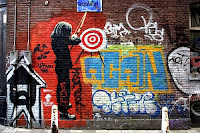 Graffiti has existed since people first drew images on cave walls. Some researchers view graffiti as “a form of communication that is both personal and free of everyday social restraints.” Others call it “part childish prank, part adult insult.” To many, it is simply vandalism. But whatever you call it, graffiti attracts the attention of linguists, art critics, anthropologists and gender experts.
Graffiti has existed since people first drew images on cave walls. Some researchers view graffiti as “a form of communication that is both personal and free of everyday social restraints.” Others call it “part childish prank, part adult insult.” To many, it is simply vandalism. But whatever you call it, graffiti attracts the attention of linguists, art critics, anthropologists and gender experts.Graffiti, which originated in Philadelphia, is a global phenomenon. In his book, Graffiti Women: Street Art from Five Continents, Nicholas Ganz shares the work of women artists from South America to Australia, South Africa to Sweden, Europe to Asia. The preface to over 1,000 images is telling. “Unlike a girl, a male writer’s reputation or identity rests upon his graffiti, not his sexual activities, his demonstrations of masculinity, not his passive physicality. At the end of the day, he occupies a sphere that grants him a presence, a competitive force and an opportunity to be recognized. That sphere would seem to be a much harder place for a woman to occupy,” writes Nancy Macdonald, author of The Graffiti Subculture.
Graffiti researchers have often found themselves in restrooms, where women feel free and safe to write. “It’s the ultimate place to purge,” notes one researcher. But most people interested in graffiti, like documentary filmmaker Jon Reiss, have focused on surfaces outside of public restrooms. His 2007 film “Bomb It” explored the explosion of graffiti culture throughout the world and raised critical questions about public space and “the war being waged for it.”
Lady Pink now works with schools teaching young artists. Her work appears in gallery and museum shows. “The purpose of graffiti,” she says, “is to maintain the spirit of rebellion in society. It’s important that young artists are questioning the status quo and thinking outside the box. Who says art belongs inside galleries and must be seen in silence? Why not on the street where everyone can do it?”
There is greater gender balance and increased tolerance for street art today. Women feel safer and there appear to be fewer legal implications, although some argue that sanctions are still tough. Still, says Lady Pink, writers seek the thrill and excitement that comes with writing on forbidden spaces. “To decriminalize it would take all the fun out of it!”

No comments:
Post a Comment